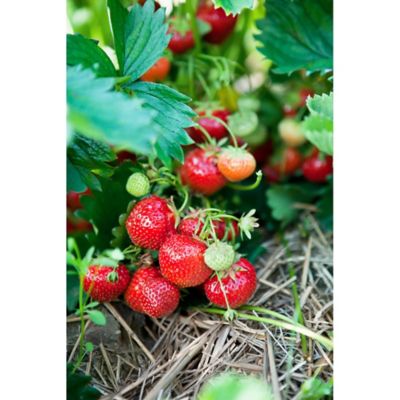Although strawberries are easily identified, there are numerous myths about how they grow. Strawberries can be found on trees, bushes, and vines. This guide aims to clarify the strawberry plant’s identification so that gardeners know what to expect.
Do Strawberries Grow on Trees?
Oranges, apples, coconuts, and mangoes are just a handful of the fruits that grow on trees. Strawberries, on the other hand, are not on the list. The strawberry tree, or Arbutus unedo, may have contributed to the erroneous assumption that strawberries grow on trees.
The strawberry tree, you see, doesn’t produce any of the strawberries you’re used to. The berries do develop small red fruits, but the hue of the berries is identical to that of genuine strawberries. It’s advisable to check closely if you see these trees, especially if you’re in USDA hardiness zones 8 to 11.
Do Strawberries Grow on Bushes?
If strawberries aren’t planted on trees, they may be cultivated on bushes. They do, after all, grow above earth. A strawberry plant, unlike bushes like oakleaf hydrangea and rhododendron, does not have woody stems that stay upright. So it isn’t technically a bush.
Nonetheless, stating that strawberry bushes exist is not incorrect. The problem is that these trees are comparable to so-called strawberry trees in that they don’t produce strawberries. Instead, in the fall, the strawberry bush, Euonymus americanus, produces five-lobed reddish red fruits with a diameter of 0.75 inches.
Do Strawberries Grow on Vines?
Although strawberries can be found on trellises, they do not grow on vines. They have runners, which are horizontally growing stems with buds on the terminal tips. These buds will eventually develop into new strawberry plants.
Strawberry plants also have a different growth pattern than actual vine plants like wisteria and bougainvillea. Strawberries only grow long stems for the sake of reproduction, whereas vines do so on a regular basis.
So, what kind of soil do strawberries prefer? Runners, not vines, bushes, or trees, make up the majority of them. Some strawberry kinds have longer runners than others, which is why gardeners use trellises to encourage them to grow vertically rather than spreading throughout the garden.
After a month, runners usually grow. You should already have trellises and garden tape in place at this time. Allow the runners to grow and create buds if you want additional strawberries. If they are already damaging other plants, you can always cut them down.
Strawberries Can Be Grown Almost Anywhere
The best-tasting fruits are grown in direct sunlight. Select a sunny, protected area with healthy, well-draining, somewhat acidic soil. Before planting, enrich the soil by digging in a lot of organic matter, such as compost or well-rotted manure. Your new plants will benefit from a general-purpose organic fertilizer. If you can, avoid planting strawberries in frost-prone areas to protect early flowering kinds, and don’t grow them near tomatoes, potatoes, or chrysanthemums, as these plants are susceptible to verticillium wilt, a disease that may easily be passed on to strawberries.
Strawberries may be grown in containers, towers, and even hanging baskets, making them a very versatile crop.
Prepare your senses for an adventure if you’ve never grown your own strawberries before because here’s our planting to harvest a guide to strawberries! Alternatively, you can learn more about strawberries and how to grow them here:
Strawberries come in a variety of shapes and sizes.
In terms of flavor, homegrown strawberries outperform store-bought strawberries, which are sometimes plucked before they’re ready. This is significant because fully ripened strawberries have a higher sugar content and a stronger scent, implying that they have more flavor.
Summer-fruiting or June-bearing varieties, which produce their fruits in one go over a few short weeks in early summer, and everbearing or perpetual varieties, which produce two smaller harvests – the first in early summer and the second toward the end of summer – make up the majority of strawberries. There are also day-neutral strawberries, which produce intermittently during the growing season. If you enjoy strawberries, plant a variety of cultivars so you can enjoy them over a longer period of time.
How to Grow Strawberries
Strawberries are available in pots or plug packs throughout the growing season, although bare-root plants are typically marketed later in the season and again in early spring.
Plant strawberries so that the plant’s crown is at soil level.
Plants should be spaced about 20 inches (50 cm) apart in each direction, with a string line serving as a guide to ensure nice, straight rows. The plant’s crown, where the leaves emerge, should be level with the soil. The easiest way to do this is with potted strawberries, which may be planted at the same depth as they were in their nursery pots.
To revive the roots of bare-root strawberries, immerse them in water for an hour or so. Remove them from the water and trim any straggly roots that have grown too long. Don’t worry, the plant will not be harmed! Now dig a hole large enough to fit the roots in. With one hand, hold the crown at the proper level, then with the other, fill the earth back in around the roots before firming into place. When you’re finished, water the plants thoroughly to help them settle in.
Strawberries can be planted considerably closer together in containers, but they will need to be divided and replanted after one season to stay healthy. Make sure the container has drainage holes in the bottom and use all-purpose potting soil.
Once the plants begin to flower, fertilize them on a regular basis.
Strawberry Planting
Plants should be watered on a regular basis as they grow and during dry seasons. To limit the danger of disease, avoid soaking the leaves when watering. Strawberry plants growing in containers will need to be watered more frequently because the potting soil can dry out rapidly in hot weather.
Strawberries devote a lot of effort into inflating their fruits, so replenish soil fertility before the plants resume growth in the spring by sprinkling in a general-purpose organic fertilizer. From the time plants begin to flower, container strawberries will require feeding as much as once a week. For this, use a potassium-rich liquid fertilizer, such as store-bought tomato feed or homemade comfrey feed.
Straw mulch strawberries to keep the fruits off the soil and weed competition at bay.
Early in the summer, before the fruits grow, tuck a straw mulch in and around the plants. This will maintain them blemish-free while also delaying weed growth and soil moisture loss. Cut off any runners – long, thin shoots like this – in the first year to focus the plants’ efforts on fruit production. You can use these to propagate new plants in the future.
Bonus Tip
Birds, like us, adore strawberries and may devour blossoming crops in a flash if they’re hungry. Covering plants with netting that excludes birds but enables pollinating insects to get through is the best way to keep your produce safe. The other danger is a cold spell early in the season, when early blossoms are vulnerable to frost damage. When frost threatens while the plants are flowering, keep an eye on the weather forecast and deploy row coverings. During the day, remember to remove the covers to allow pollinators access.
Slugs can gnaw at the fruits as well. Slug traps filled with beer can be used to keep them away from your plants, or you can grow them in pots out of harm’s way.
Additionally, it is important that you use the right seeds for growing strawberries.









